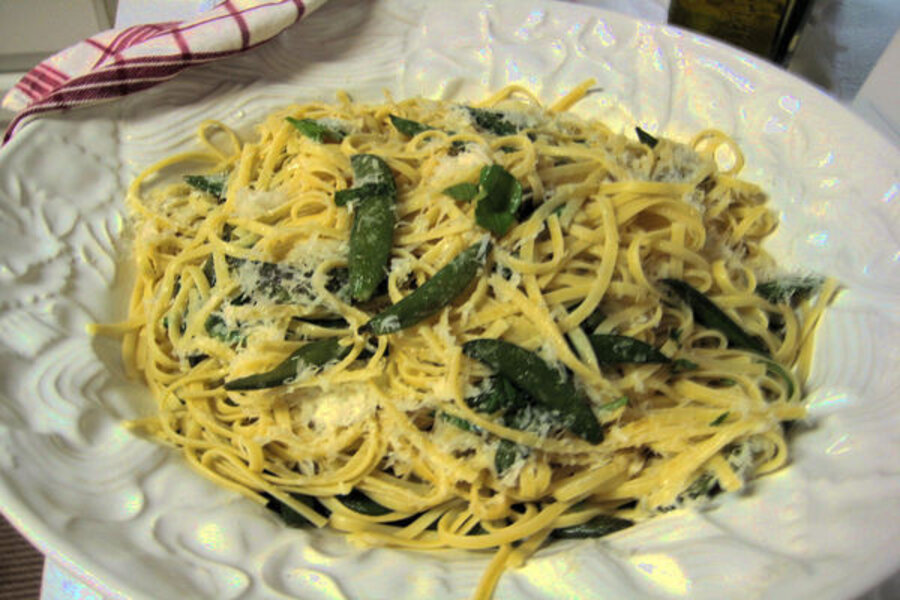How to grow and serve sugar snap peas
Loading...
If you haven’t grown sugar snap peas, you just don’t know what you are missing, says Ann, the gardener.. These are the peas you eat whole, pod and all, without having to shell.
Along with the original Sugar Snap pea, you can try several varieties with names like Sugar Ann, Sugar Daddy, and Super Sugar Snap. They are sweet and crunchy right off the vine (many are stringless) and they are favorites for salads, stir-fries, and recipes like Linda’s Sugar Snaps and Pasta, which follows.
My favorite is still the original Sugar Snap, even though it is tall, needs a fence to climb, and has to have its strings removed, just as old-fashioned green beans do.
Peas have to be planted early or late, as your climate dictates. In Northern climes, early spring planting is a bonus since gardeners can’t wait to get their hands in the soil and get things growing.
When to plant sugar snaps in the South
Cool-weather plants such as sugar snap peas are a special trial in Southern gardens. They dislike cold, wet soils of winter, but are not suited to spring or fall planting because spring jumps into hot summer quickly most years, or fall soils are overheated by the intensely hot summer temperatures.
In my section of South Carolina, it is best to plant peas Thanksgiving weekend for an extra-early spring crop. Peas withstand temperatures down to 20 degrees F. (7 C).
If you are in Zones 7 or 8 and decide to try winter growing, remember that just because the pea seedling doesn’t jump up does not mean it’s languishing in the soil. Roots are emerging.
Green seedlings surface during winter warm spells, stop growing when the weather turns cold and icy, and then suddenly get growing in earnest, blooming and setting their pods in March and April.
Rarely do all of the peas make it to the kitchen. They are so sweet and crunchy right from the vine that I eat as many as I put in the basket. If, in a weak moment, you let friends try the sugar snaps, they will be back for more. Plant plenty.
Now is a good time to order your sugar snap pea seeds for winter planting. Not all seed companies will ship seeds in the fall or winter months.
Sugar snaps and pasta
Talk about good, says Linda, the chef. Just put these few ingredients together, and you have a good meal.
Think fresh sugar snaps and basil from the garden, linguine from the pantry, and Parmigiano-Reggiano from the refrigerator. It just cannot be beat. In fact, my mouth is watering just thinking about the olive oil and butter that browned as I sautéed the sweet sugar snaps and added all that golden goodness to the pasta.
Add some freshly grated cheese, a handful of fresh basil, and you’ve got one delicious light meal that is as beautiful to look at as it is to taste.
For a light luncheon or dinner meal, add a salad of mixed baby greens, grapefruit or mandarin oranges, slices of red onion, and red wine vinaigrette. Simple and delicious.
Linguine With Sugar Snap Peas, Basil, and Parmesan
3/4 pound sugar snap peas
1 tablespoon butter
1 tablespoon olive oil
1/8 to 1/4 teaspoon red pepper flakes, or to taste
1 pound linguine, cooked according to package directions
Handful of fresh basil or to taste, cut into ribbons or chiffonade
1 cup freshly grated Parmesan cheese, or to taste
Salt to taste
In a skillet over medium-high heat, add the butter and olive oil. When it starts to sizzle, add the red pepper flakes and the sugar snap peas. Sauté the peas for about 4 to 5 minutes or until crisp-tender. Salt to taste.
Add the pasta to a large bowl, and then add the sugar snap peas along with the olive oil and butter from the skillet. Mix well, add cheese and basil, and serve immediately.
If you like garlic and you would like to include it in this dish, add it to the butter and olive oil at the same time that you add the red pepper flakes. Just make sure that you keep stirring so that the garlic does not burn. Serves 6.
Editor's Note: To read more of Anne and Linda's "how to grow and prepare" series, click here.
-----
Linda Weiss and Anne Moore met while Linda was the food editor and Anne was the garden editor for South Carolina Homes & Gardens magazine. They now write articles for the ETV GardenSMART television show website, where Anne is the horticulture editor, gardening consultant, and e-newsletter editor. Anne has written for magazines and newspapers. She is a member of and a recipient of a Silver Award for magazine writing from the Garden Writers Association. Linda is a personal chef. She attended Le Cordon Bleu of Paris’ catering program, has appeared as a guest chef on numerous television shows, has been a culinary educator for 10 years, and a food writer for a number of magazines. She is a professional member of The James Beard Foundation and the Southern Foodways Alliance. She has written a cookbook, "Memories From Home, Cooking with Family and Friends."





